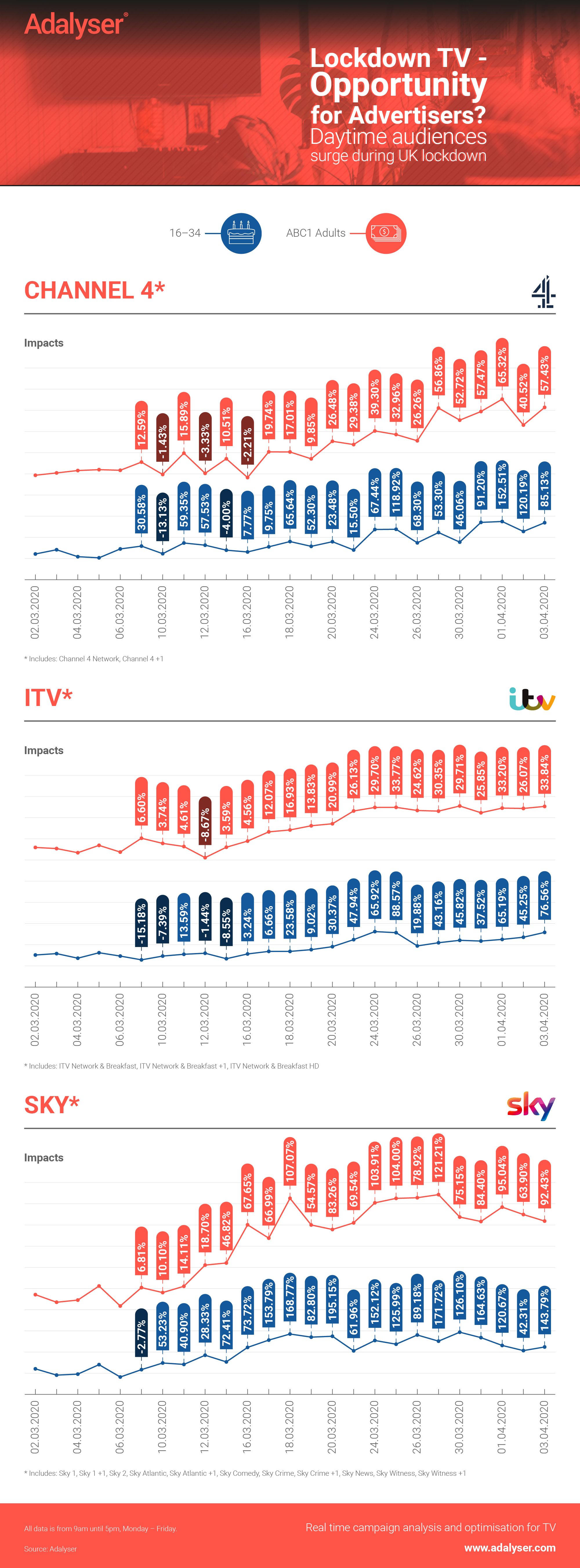Practical fixes to help TV advertising become more agile

Sponsored content
David Cloudsdale looks at what can be done to make TV advertising more nimble
At Adalyser we recently undertook an in-depth analysis of viewing behaviour during the Covid-19 lockdown. It may come as no surprise that TV audiences have surged (see infographic). This seemed like an opportunity – hard to reach, desirable TV audiences were suddenly sitting in front of TV screens during the day.
However, when I spoke to media people about the opportunity, their response was a collective shrug of the shoulders. Interesting research, but broadcast TV advertising is not agile enough to support campaigns that adapt to live situations.
Why is this the case? Surely it is just demand, supply and admin. What can be done to make TV advertising more nimble?
AB Deadlines
The current crisis has tended to magnify flaws, quirks and bottlenecks in every business. AB (advanced bookings) deadlines is one example for TV advertising. Sales houses operate AB deadlines of approx. 6-8 weeks. This means a TV campaign must be booked 6-8 weeks in advance of the live date. Failure to hit this deadline results in a ‘late penalty charge’. Here are the AB deadlines for 2020:
Advert first broadcast during January 2020 > Deadline day 29 October
February 2020 > 26 November
March 2020 > 7 January
Within the context of a lockdown, surging daytime TV audiences and declining advertising revenues – it looks like inflexible madness. And it’s not like the inflexibility of this approach has only just been exposed by the crisis.
Back in March 2018, under the headline ‘ITV drops late penalty charge for ad bookings to woo advertisers’, Campaign magazine reported an ‘unprecedented’ move to drop penalty charges.
Media agencies had to be reassured it wasn’t an April Fools joke. This is not a good look. In a world where the competition is delivering real time auctions for digital inventory – broadcasters are wooing advertisers with a promise to not impose penalties for not knowing exactly what they will be doing in 7 week’s time. Marketeers call this being agile.
We’re not suggesting that broadcasters should hit revenues by simply removing charges. However the current model is inflexible and does not meet the needs of an increasingly agile customer base. How about a range of advertising packages designed to fit different scenarios?
Done correctly it should maintain or even increase revenues. And please let’s drop terms like ‘penalty fees’. Language is very important. Look at how a feature of broadcast TV (scale) and has been framed as a fault (wastage).
As an example, one of Adalyser’s significant costs is cloud computing. The cloud computing sales proposition rewards customer commitment but the priority, language and process is the opposite of TV. When we started the process of migrating to the cloud, there was no talk about long-term commitment.
We were encouraged to get setup as quickly as possible. There was reassurance that moving quickly and testing the service was a typical (and wise) inception path for the majority of customers. There were no fines or penalties for not knowing what we were going to do in 6 weeks time.
But the moment we had completed our testing, we were offered discounts for longer term commitments. The percentages literally made our eyes pop. They were huge. And they were driven by exactly the same economic motivation as late booking fees. Just instead of being clobbered with a penalty fee we were rewarded with a discount.
As the crisis unfolded, broadcasters announced they were suspending late booking charges for March, April and May. But reading the announcement just served to highlight TV’s archaic sales process and priorities.
TV industry insiders may view the repackaging of a sales process with a degree of cynicism. But in a year from now, a digital first, direct to consumer advertiser will be in the process of considering linear TV advertising.
And when they are presented with a TV sales proposition that mirrors their other procurement experiences, it will encourage a smoother sales process and raise fewer red flags.
Deadlines will reflect real world constraints. The language of penalty fees will be removed from the conversation. Instead there will a range of advertising options, packaged to meet the needs of the advertiser and priced accordingly.
Approval Process
Standards, regulation and a robust appeals process are crucial to TV. Viewers trust the adverts they watch. TV elevates the credibility of an advertiser because standards confer legitimacy. It is a critical element of the implicit contract between commercial TV and the viewing public – great content in exchange for approved, trusted, high quality advertising. This is a huge USP when compared to the digital advertising space.
Clearcast provides clearance services in the UK. Before adverts are shown, Clearcast checks them against the UK Code of Broadcast Advertising (BCAP for linear, CAP for on-demand). This sets out what is permitted and what is not. If an advertiser claims 10m mobile app downloads – is it true and how is it verified?
The approval process is by necessity an iterative process – submit a script, Clearcast reviews it and responds with feedback. Submit a rough edit, Clearcast reviews it and responds with feedback. Etc, etc. Each iteration takes a few days. The advice on the Clearcast website is to leave at least 2-3 working weeks for the approval process.
The standard Clearcast service is free of charge. In addition, there is a Fast track service that guarantees feedback on each submission within 24 hours. The Fast track cost is £500+ VAT for each submission. £0 for standard or £500 per Fast track submission seems an odd charging policy. Given that any manual approval process is an inherently resource heavy operation – why is the basic service free of charge?
The speed of the approval process must (in part) be a function of available resource. Given the value added by Clearcast and the importance of standards for TV why not charge a small fee per approved advert? Looking at Adalyser’s Clearcast attribution data, approx. 29,000 adverts were approved during 2019.
If the fee was £100 per approval it would generate £2.9m in revenues. This would be a tiny percentage of the advertiser’s overall cost but could have a huge impact on the resources and technology required to drive down approval times for everyone.
The interesting thing about this idea is that it comes from a production company (thanks Sam at Paragon). Paragon would be on the receiving end of this charge – either absorbing it as part of their service fee or passing it on to the advertiser. Paragon’s priority is speed to screen. A small service fee is a worthwhile cost for shorter approval times.
Data
How long does it take to report TV spot data (dates, times, programmes, impacts, costs)? Depending on who you ask the answer maybe 9 days post broadcast. This is because not all adverts are watched ‘live’. Some adverts are consumed via a recording on a PVR such as Sky+. The broadcasters rightly want to ensure that every impact delivered by the campaign is included in the final tally.
Therefore, the cost of any TV spot must include both live viewing and viewing via a recording. This is not an inefficiency. It is simply part of the process. You literally have to give people time to watch the recorded show if you are going to count the impacts it delivered.
Watching a digital first advertiser react to this news is not a pretty sight. They do a quick mental calculation of how much they will spend before they can even begin to start measuring TV performance. What follows is not suitable for print…
But wait – this can’t be the end of the story can it? Of course not.
Spot data goes through a lifecycle: planned -> live -> consolidated. The planned stage is a snapshot of a TV schedule at a point in time. But it’s a fluid environment – so spots can and do move. Live is the actual broadcast time (accurate to the second). Consolidated is the final state that includes delayed viewing via PVRs.
Live data is exactly what an advertiser requires to measure TV performance and it’s available the day after broadcast.
The issue with TV data is twofold. Firstly, the lifecycle is not widely understood. This leads to miscommunication about what is achievable. Secondly, the data is fragmented across various data sources. It’s all there – but it needs to be pieced together. This can be time consuming.
To fix this situation, Adalyser now provides media agencies with automated, daily access to costed live spot data, no matter how complicated the buying plan. It sounds simple, but trusted, accurate, timely data drives innovation and efficiency.
As an example – Adalyser Campaign Management now automatically monitors broadcast TV campaigns against pre-defined delivery targets and value positions. If an advertiser wants to know the exact state of their live TV campaign – it’s all available as an online dashboard in near real-time.
It feels a lot more like digital. And the advantage of feeling a lot more digital is that TV becomes more relevant to a wider range of advertisers.
Adalyser is working with brilliant, existing solutions such as CARIA to deliver a powerful, integrated end-to-end TV advertising platform. And that is the point. A lot of the components already exist. It’s just a matter of joining them together, smoothing the data flows and presenting a compelling package to advertisers.
None of this stuff is glamorous. But it’s practical steps to fix the here and now and help sell more TV.
David Cloudsdale is a co-founder of Adalyser





